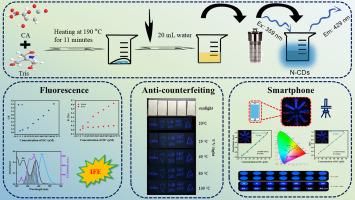Rapid and facile synthesis of nitrogen-doped carbon dots for fluorescence-smartphone dual-mode detection of doxycycline and anti-counterfeiting applications
IF 4.9
2区 化学
Q1 CHEMISTRY, ANALYTICAL
引用次数: 0
Abstract
The extensive use of antibiotics in livestock has raised concerns regarding the potential presence of harmful residue levels in animal feed and food products. Herein, nitrogen-doped carbon dots (N-CDs) are rapidly synthesized via pyrolysis with citric acid (CA) and tris(hydroxymethyl)aminomethane (Tris) as precursors. The N-CDs exhibit optimal excitation/emission at 359/429 nm and a quantum yield of 56 %. A novel fluorescence sensing system based on smartphones has been created for the dual-mode detection of doxycycline (DC) by utilizing the inner filter effect (IFE) to quench fluorescence. The platform shows two linear ranges of 1.5–16.7 μM and 16.7–66.8 μM, with corresponding limits of detection (LOD) of 0.45 and 0.81 μM, respectively. The method quantifies DC in milk samples with recoveries of 98.80 %–103.90 %, validating its accuracy and practicality. Furthermore, the N-CDs enable DC monitoring in human hepatocarcinoma cells (SMMC-7721) and zebrafish, owing to their minimal toxicity and outstanding biocompatibility. Interestingly, the N-CDs embedded in the filter paper have remarkable thermal stability in the range of 20–100 °C, even after being heated at 100 °C for 60 min. Their outstanding optical properties enable their use in invisible ink for encryption and anti-counterfeiting. This dual-mode platform has shown significant potential in environmental monitoring and advanced security technologies.

用于荧光-智能手机双模检测强力霉素和防伪应用的氮掺杂碳点的快速简便合成
在牲畜中广泛使用抗生素引起了人们对动物饲料和食品中可能存在有害残留水平的担忧。本文以柠檬酸(CA)和三(羟甲基)氨基甲烷(tris)为前体,通过热解快速合成了氮掺杂碳点(N-CDs)。N-CDs在359/429 nm处表现出最佳的激发/发射,量子产率为56%。建立了一种基于智能手机的荧光传感系统,利用内滤效应(IFE)猝灭荧光,实现了强力霉素(DC)的双模检测。该平台线性范围为1.5 ~ 16.7 μM和16.7 ~ 66.8 μM,检出限分别为0.45 μM和0.81 μM。该方法定量测定牛奶样品中的DC,回收率为98.80% ~ 103.90%,验证了方法的准确性和实用性。此外,由于N-CDs具有极小的毒性和出色的生物相容性,因此可以在人肝癌细胞(SMMC-7721)和斑马鱼中进行DC监测。有趣的是,嵌入滤纸的N-CDs在20-100°C范围内具有显著的热稳定性,即使在100°C加热60分钟后也是如此。其杰出的光学特性使其能够用于加密和防伪的隐形墨水。这种双模平台在环境监测和先进安全技术方面显示出巨大的潜力。
本文章由计算机程序翻译,如有差异,请以英文原文为准。
求助全文
约1分钟内获得全文
求助全文
来源期刊

Microchemical Journal
化学-分析化学
CiteScore
8.70
自引率
8.30%
发文量
1131
审稿时长
1.9 months
期刊介绍:
The Microchemical Journal is a peer reviewed journal devoted to all aspects and phases of analytical chemistry and chemical analysis. The Microchemical Journal publishes articles which are at the forefront of modern analytical chemistry and cover innovations in the techniques to the finest possible limits. This includes fundamental aspects, instrumentation, new developments, innovative and novel methods and applications including environmental and clinical field.
Traditional classical analytical methods such as spectrophotometry and titrimetry as well as established instrumentation methods such as flame and graphite furnace atomic absorption spectrometry, gas chromatography, and modified glassy or carbon electrode electrochemical methods will be considered, provided they show significant improvements and novelty compared to the established methods.
 求助内容:
求助内容: 应助结果提醒方式:
应助结果提醒方式:


